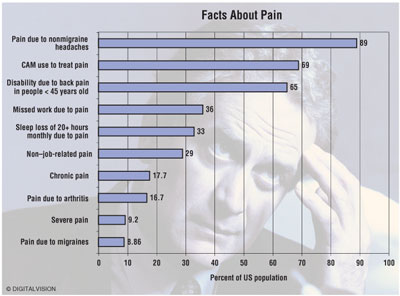US
Pharm. 2006;5:11.
According to the American Pain
Foundation, more than 80 million people (68% of all full-time employees)
suffer from pain-related conditions, and more than 17 million people took sick
days in 1995 due to pain conditions, resulting in 50 million lost workdays.
Among pain sufferers, 80%
experienced short-term disability; 18% of these attributed pain to
work-related injuries. Forty percent of pain sufferers had joint
pain/aching/stiffness, with 23% suffering for up to 10 weeks, according to the

Arthritis, back pain, cancer, and
headache are the major contributors to onset of pain. Twenty-six million women
suffer from arthritis, and an equal number of Americans between the ages of 20
and 64 experience frequent back pain. A majority (68%) of adults in the
Although 70% of cancer
patients suffer from significant pain, only half receive treatment for pain.
Some people avoid taking pain medication because they fear they may become
addicted to the drug. Yet, when pain is intolerable, 67% of Americans use high
doses of pain medications like morphine, despite being warned of the high risk
of addiction. Nonsteroidal anti-inflammatory drugs (NSAIDs) are the most
common prescription medications used for pain relief, and 70% of pain
sufferers self-medicate with painkillers.
An increasing number of
Americans are turning to complementary and alternative medicine (
To comment on this article, contact editor@uspharmacist.com.






